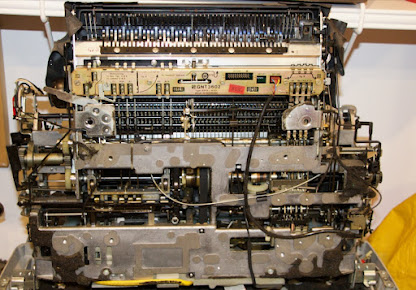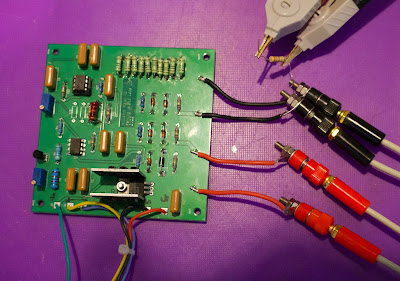I bought a beautiful Farnell L30-5 PSU - sold as faulty, not working. It's a thing of some beauty, with big meters on it. The former owner was correct - out of the box, it produced no output. The fuses were all intact, but when I turned it on, the overcurrent LED lit up, regardless of the setting of the knobs. Now though I was on a conference call at work at the time, I turned the camera off, carried on listening to the conversation, and got my screwdrivers out.
So, time to go inside. I found a schematic online, and I found my way to the overcurrent LED driver. It was holding the output transistors in high impedance. It was a fairly simple thing to find that it was being driven by an op amp, that compared two voltages - one generated across a low value resistor in series with the output, and one from the current limit pot. Interesting to see that one of the voltages on the op amp was at or near the negative rail. I measured the resistance between the two pins on the op amp - pins 4 and 5, and it measured a few ohms. I concluded that the op amp had failed, I checked on t'Internet to find a close equivalent, and discovered that a good old TL072 would do the trick, and we have oodles of those around for the synth stuff. I even found an 8 pin socket ready to go in.
Took the board out - and I wish I had taken pictures, but there was a small area, about a centimetre across on the coppers side of the board, which looked like a fuzzy crystalline structure had grown out of the solder connections. Bright, shiny solder except for this one grey, fuzzy mess - like a metallic mould.
I've read about whiskers affecting older equipment before - it happens with different metals - sometimes zinc, sometimes lead and with a voltage across. Never seen it - a bit apocryphal I have always thought. I wiped the crystals with a cloth, then with a small bit of sanding block used for cleaning PCBs. I then took a soldering iron to it, just to tidy it up. Measured the resistance again, and the near short was gone. Not even a need to replace the op amp?
Excellent repair. By the time the conference call was over, I had cleaned the insides with isopropyl, hoovered out the dust bunnies and put the screws back in the case.

.jpeg)












